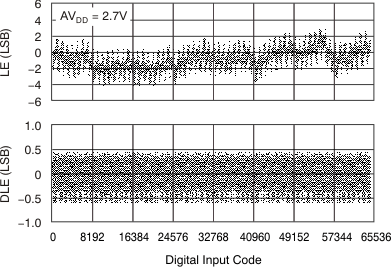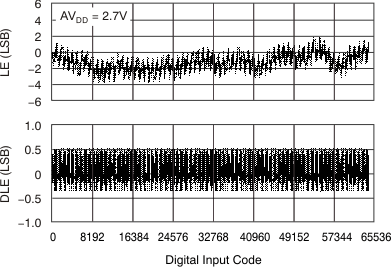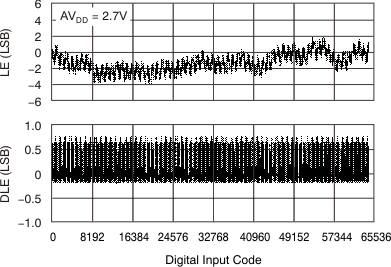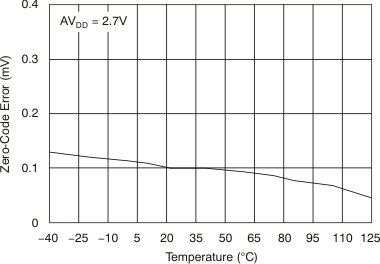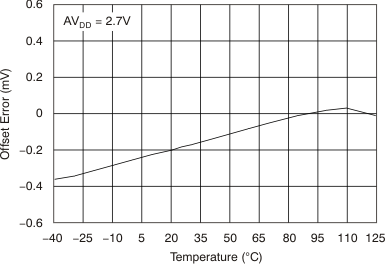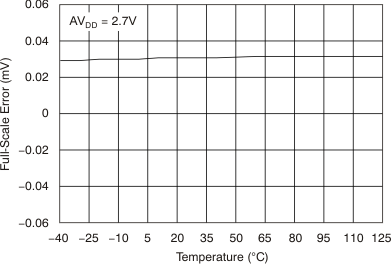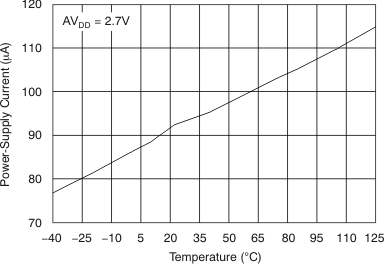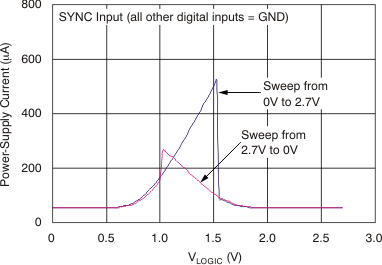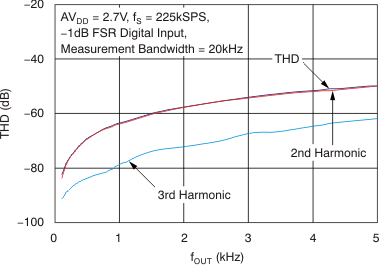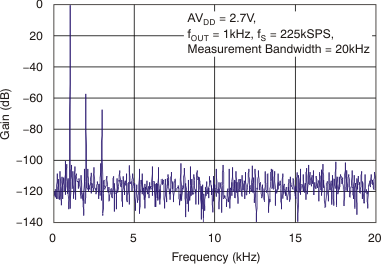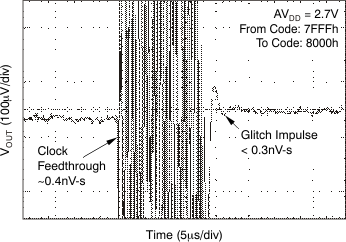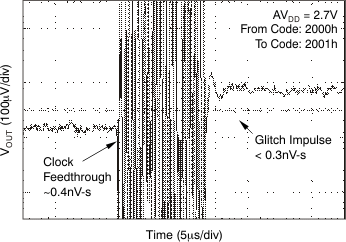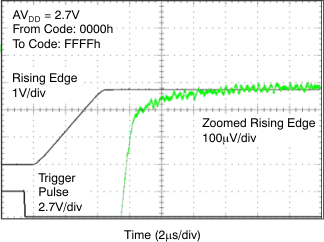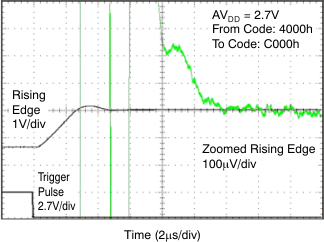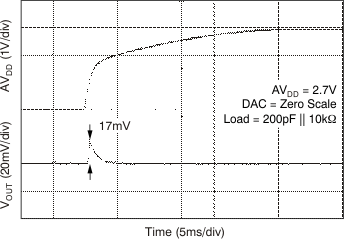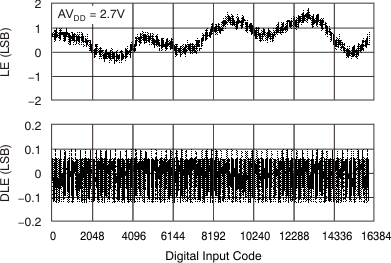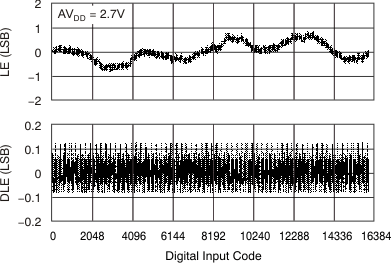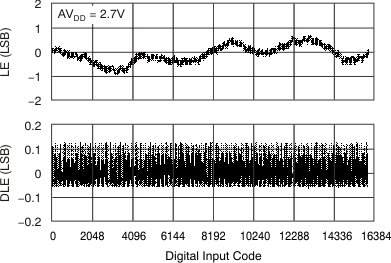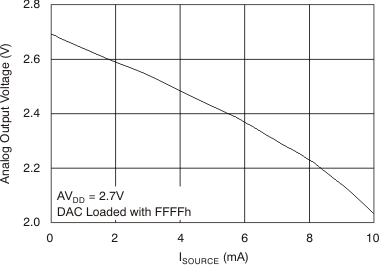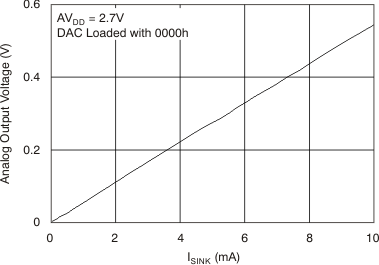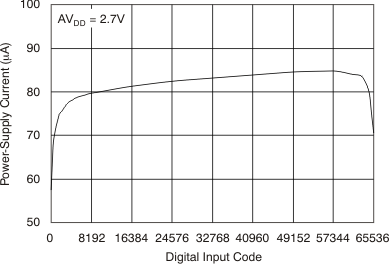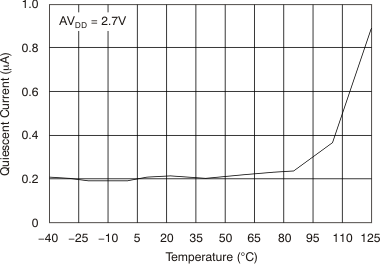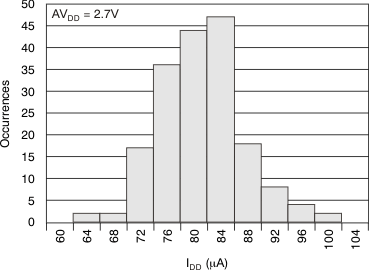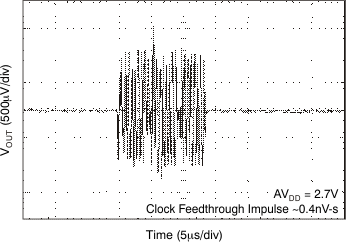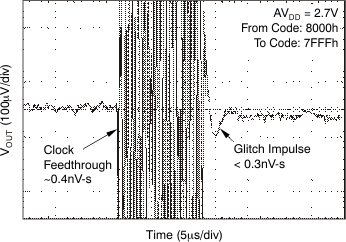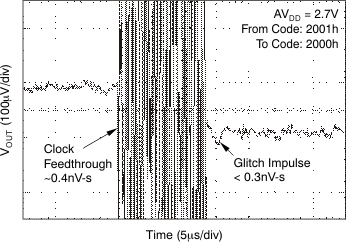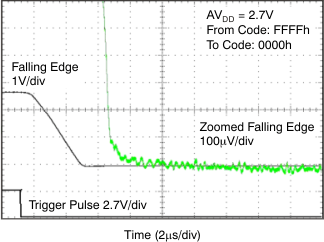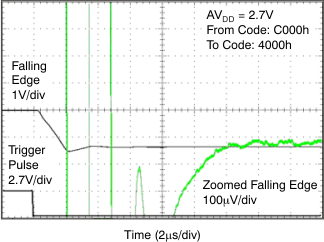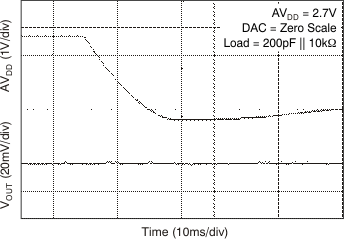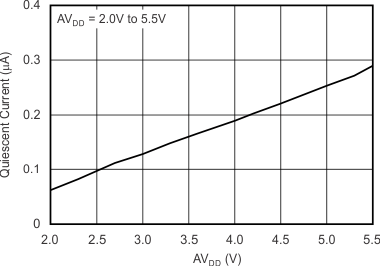SBAS439C August 2008 – July 2015 DAC8311 , DAC8411
PRODUCTION DATA.
- 1 Features
- 2 Applications
- 3 Description
- 4 Revision History
- 5 Device Comparison
- 6 Pin Configuration and Functions
- 7 Specifications
- 8 Detailed Description
- 9 Application and Implementation
- 10Power Supply Recommendations
- 11Layout
- 12Device and Documentation Support
- 13Mechanical, Packaging, and Orderable Information
7 Specifications
7.1 Absolute Maximum Ratings
over operating free-air temperature range (unless otherwise noted)(1)| MIN | MAX | UNIT | ||||
|---|---|---|---|---|---|---|
| Voltage | AVDD to GND | –0.3 | 6 | V | ||
| Digital input voltage to GND | –0.3 | AVDD +0.3 | V | |||
| VOUT to GND | –0.3 | AVDD +0.3 | V | |||
| Temperature | Junction, TJ max | 150 | °C | |||
| Storage, Tstg | –65 | 150 | °C | |||
(1) Stresses beyond those listed under Absolute Maximum Ratings may cause permanent damage to the device. These are stress ratings only, which do not imply functional operation of the device at these or any other conditions beyond those indicated under Recommended Operating Conditions. Exposure to absolute-maximum-rated conditions for extended periods may affect device reliability.
7.2 ESD Ratings
| VALUE | UNIT | |||
|---|---|---|---|---|
| V(ESD) | Electrostatic discharge | Human-body model (HBM), per ANSI/ESDA/JEDEC JS-001(1) | ±1000 | V |
| Charged-device model (CDM), per JEDEC specification JESD22-C101(2) | ±500 | |||
(1) JEDEC document JEP155 states that 500-V HBM allows safe manufacturing with a standard ESD control process.
(2) JEDEC document JEP157 states that 250-V CDM allows safe manufacturing with a standard ESD control process.
7.3 Recommended Operating Conditions
over operating free-air temperature range (unless otherwise noted)| MIN | NOM | MAX | UNIT | ||
|---|---|---|---|---|---|
| TA | Operating temperature | –40 | +125 | °C | |
| AVDD | Supply voltage | 2.0 | +5.5 | V | |
7.4 Thermal Information
| THERMAL METRIC(1) | DAC8x11 | UNIT | |
|---|---|---|---|
| DCK (SC70) | |||
| 6 PINS | |||
| RθJA | Junction-to-ambient thermal resistance | 216.4 | °C/W |
| RθJC(top) | Junction-to-case (top) thermal resistance | 52.1 | °C/W |
| RθJB | Junction-to-board thermal resistance | 65.9 | °C/W |
| ψJT | Junction-to-top characterization parameter | 1.3 | °C/W |
| ψJB | Junction-to-board characterization parameter | 65.2 | °C/W |
| RθJC(bot) | Junction-to-case (bottom) thermal resistance | N/A | °C/W |
(1) For more information about traditional and new thermal metrics, see the Semiconductor and IC Package Thermal Metrics application report, SPRA953.
7.5 Electrical Characteristics
at AVDD = 2 V to 5.5 V, RL = 2 kΩ to GND, and CL = 200 pF to GND, and TA = –40°C to +125°C unless otherwise noted.| PARAMETER | TEST CONDITIONS | DAC8411, DAC8311 | UNIT | ||||
|---|---|---|---|---|---|---|---|
| MIN | TYP | MAX | |||||
| STATIC PERFORMANCE(1) | |||||||
| DAC8411 | Resolution | 16 | Bits | ||||
| Relative accuracy | Measured by the line passing through codes 485 and 64714 | 3.6 V to 5 V | ±4 | ±8 | LSB | ||
| 2 V to 3.6 V | ±4 | ±12 | |||||
| Differential nonlinearity | ±0.5 | ±2 | LSB | ||||
| DAC8311 | Resolution | 14 | Bits | ||||
| Relative accuracy | Measured by the line passing through codes 120 and 16200 | ±1 | ±4 | LSB | |||
| Differential nonlinearity | ±0.125 | ±1 | LSB | ||||
| Offset error | Measured by the line passing through two codes(2) | ±0.05 | ±4 | mV | |||
| Offset error drift | 3 | μV/°C | |||||
| Zero code error | All zeros loaded to the DAC register | 0.2 | mV | ||||
| Full-scale error | All ones loaded to DAC register | 0.04 | 0.2 | % of FSR | |||
| Gain error | 0.05 | ±0.15 | % of FSR | ||||
| Gain temperature coefficient | AVDD = 5 V | ±0.5 | ppm of FSR/°C | ||||
| AVDD = 2 V | ±1.5 | ||||||
| OUTPUT CHARACTERISTICS | |||||||
| Output voltage range | 0 | AVDD | V | ||||
| Output voltage settling time(3) | RL = 2 kΩ, CL = 200 pF, AVDD = 5 V, 1/4 scale to 3/4 scale |
6 | 10 | μs | |||
|
RL = 2 MΩ, CL = 470 pF |
12 | μs | |||||
| Slew rate | 0.7 | V/μs | |||||
| Capacitive load stability | RL = ∞ | 470 | pF | ||||
| RL = 2 kΩ | 1000 | pF | |||||
| Code change glitch impulse | 1LSB change around major carry | 0.5 | nV-s | ||||
| Digital feedthrough | 0.5 | nV-s | |||||
| Power-on glitch impulse | RL = 2 kΩ, CL = 200 pF, AVDD = 5 V | 17 | mV | ||||
| DC output impedance | 0.5 | Ω | |||||
| Short-circuit current | AVDD = 5 V | 50 | mA | ||||
| AVDD = 3 V | 20 | mA | |||||
| Power-up time | Coming out of power-down mode | 50 | μs | ||||
| AC PERFORMANCE | |||||||
| SNR | TA= 25°C, BW = 20 kHz, 16-bit level, AVDD = 5 V, fOUT = 1 kHz, 1st 19 harmonics removed for SNR calculation |
88 | dB | ||||
| THD | –66 | dB | |||||
| SFDR | 66 | dB | |||||
| SINAD | 66 | dB | |||||
| DAC output noise density(4) | TA= 25°C, at zero-scale input, fOUT = 1 kHz, AVDD = 5 V |
17 | nV/√Hz | ||||
| TA= 25°C, at mid-code input, fOUT = 1 kHz, AVDD = 5 V |
110 | nV/√Hz | |||||
| DAC output noise(5) | TA= 25°C, at mid-code input, 0.1 Hz to 10 Hz, AVDD = 5 V |
3 | μVpp | ||||
| LOGIC INPUTS(3) | |||||||
| Input current | ±1 | μA | |||||
| VINL, input low voltage | AVDD = 2.7 V to 5.5 V | 0.3 × AVDD | V | ||||
| AVDD = 2 V to 2.7 V | 0.1 × AVDD | V | |||||
| VINH, input high voltage | AVDD = 2.7 V to 5.5 V | 0.7 × AVDD | V | ||||
| AVDD = 2 V to 2.7 V | 0.9 × AVDD | V | |||||
| Pin capacitance | 1.5 | 3 | pF | ||||
| POWER REQUIREMENTS | |||||||
| AVDD | 2 | 5.5 | V | ||||
| IDD | Normal mode | VINH = AVDD and VINL = GND, at mid-scale code(6) | AVDD = 3.6 V to 5.5 V | 110 | 160 | μA | |
| AVDD = 2.7 V to 3.6 V | 95 | 150 | |||||
| AVDD = 2 V to 2.7 V | 80 | 140 | |||||
| All power-down mode | VINH = AVDD and VINL = GND, at mid-scale code(6) | AVDD = 3.6 V to 5.5 V | 0.5 | 3.5 | μA | ||
| AVDD = 2.7 V to 3.6 V | 0.4 | 3.0 | |||||
| AVDD = 2 V to 2.7 V | 0.1 | 2.0 | |||||
| Power dissipation | Normal mode | VINH = AVDD and VINL = GND, at mid-scale code(6) | AVDD = 3.6 V to 5.5 V | 0.55 | 0.88 | mW | |
| AVDD = 2.7 V to 3.6 V | 0.25 | 0.54 | |||||
| AVDD = 2 V to 2.7 V | 0.14 | 0.38 | |||||
| All power-down mode | VINH = AVDD and VINL = GND, at mid-scale code(6) | AVDD = 3.6 V to 5.5 V | 2.50 | 19.2 | μW | ||
| AVDD = 2.7 V to 3.6 V | 1.08 | 10.8 | |||||
| AVDD = 2 V to 2.7 V | 0.72 | 8.1 | |||||
(1) Linearity calculated using a reduced code range of 485 to 64714 for 16-bit, and 120 to 16200 for 14-bit, output unloaded.
(2) Straight line passing through codes 485 and 64714 for 16-bit, and 120 and 16200 for 14-bit, output unloaded.
(3) Specified by design and characterization, not production tested.
(4) For more details, see Figure 33.
(5) For more details, see Figure 34.
7.6 Timing Requirements: 14-Bit
All specifications at –40°C to 125°C, and AVDD = 2 V to 5.5 V, unless otherwise noted.(1)(2)| PARAMETER | TEST CONDITIONS | MIN | TYP | MAX | UNIT | |
|---|---|---|---|---|---|---|
| f(SCLK) | Serial clock frequency | AVDD = 2.0 V to 3.6 V | 20 | MHz | ||
| AVDD = 3.6 V to 5.5 V | 50 | |||||
| t1 | SCLK cycle time | AVDD = 2 V to 3.6 V | 50 | ns | ||
| AVDD = 3.6 V to 5.5 V | 20 | |||||
| t2 | SCLK high time | AVDD = 2 V to 3.6 V | 25 | ns | ||
| AVDD = 3.6 V to 5.5 V | 10 | |||||
| t3 | SCLK low time | AVDD = 2 V to 3.6 V | 25 | ns | ||
| AVDD = 3.6 V to 5.5 V | 10 | |||||
| t4 | SYNC to SCLK rising edge setup time | AVDD = 2 V to 3.6 V | 0 | ns | ||
| AVDD = 3.6 V to 5.5 V | 0 | |||||
| t5 | Data setup time | AVDD = 2 V to 3.6 V | 5 | ns | ||
| AVDD = 3.6 V to 5.5 V | 5 | |||||
| t6 | Data hold time | AVDD = 2 V to 3.6 V | 4.5 | ns | ||
| AVDD = 3.6 V to 5.5 V | 4.5 | |||||
| t7 | SCLK falling edge to SYNC rising edge | AVDD = 2 V to 3.6 V | 0 | ns | ||
| AVDD = 3.6 V to 5.5 V | 0 | |||||
| t8 | Minimum SYNC high time | AVDD = 2 V to 3.6 V | 50 | ns | ||
| AVDD = 3.6 V to 5.5 V | 20 | |||||
| t9 | 16th SCLK falling edge to SYNC falling edge | AVDD = 2 V to 3.6 V | 100 | ns | ||
| AVDD = 3.6 V to 5.5 V | 100 | |||||
| t10 | SYNC rising edge to 16th SCLK falling edge (for successful SYNC interrupt) |
AVDD = 2 V to 3.6 V | 15 | ns | ||
| AVDD = 3.6 V to 5.5 V | 15 | |||||
(1) All input signals are specified with tR = tF = 3 ns (10% to 90% of AVDD) and timed from a voltage level of (VIL + VIH)/2.
(2) See Figure 1 timing diagram.
7.7 Timing Requirements: 16-Bit
All specifications at –40°C to 125°C, and AVDD = 2 V to 5.5 V, unless otherwise noted.(1)(2)| PARAMETER | TEST CONDITIONS | MIN | TYP | MAX | UNIT | |
|---|---|---|---|---|---|---|
| f(SCLK) | Serial clock frequency | AVDD = 2.0 V to 3.6 V | 20 | MHz | ||
| AVDD = 3.6 V to 5.5 V | 50 | |||||
| t1 | SCLK cycle time | AVDD = 2 V to 3.6 V | 50 | ns | ||
| AVDD = 3.6 V to 5.5 V | 20 | |||||
| t2 | SCLK high time | AVDD = 2 V to 3.6 V | 25 | ns | ||
| AVDD = 3.6 V to 5.5 V | 10 | |||||
| t3 | SCLK low time | AVDD = 2 V to 3.6 V | 25 | ns | ||
| AVDD = 3.6 V to 5.5 V | 10 | |||||
| t4 | SYNC to SCLK rising edge setup time | AVDD = 2 V to 3.6 V | 0 | ns | ||
| AVDD = 3.6 V to 5.5 V | 0 | |||||
| t5 | Data setup time | AVDD = 2 V to 3.6 V | 5 | ns | ||
| AVDD = 3.6 V to 5.5 V | 5 | |||||
| t6 | Data hold time | AVDD = 2 V to 3.6 V | 4.5 | ns | ||
| AVDD = 3.6 V to 5.5 V | 4.5 | |||||
| t7 | SCLK falling edge to SYNC rising edge | AVDD = 2 V to 3.6 V | 0 | ns | ||
| AVDD = 3.6 V to 5.5 V | 0 | |||||
| t8 | Minimum SYNC high time | AVDD = 2 V to 3.6 V | 50 | ns | ||
| AVDD = 3.6 V to 5.5 V | 20 | |||||
| t9 | 24th SCLK falling edge to SYNC falling edge | AVDD = 2 V to 3.6 V | 100 | ns | ||
| AVDD = 3.6 V to 5.5 V | 100 | |||||
| t10 | SYNC rising edge to 24th SCLK falling edge (for successful SYNC interrupt) |
AVDD = 2 V to 3.6 V | 15 | ns | ||
| AVDD = 3.6 V to 5.5 V | 15 | |||||
(1) All input signals are specified with tR = tF = 3 ns (10% to 90% of AVDD) and timed from a voltage level of (VIL + VIH)/2.
(2) See Figure 2 timing diagram.
 Figure 1. Serial Write Operation: 14-Bit (DAC8311)
Figure 1. Serial Write Operation: 14-Bit (DAC8311)
 Figure 2. Serial Write Operation: 16-Bit (DAC8411)
Figure 2. Serial Write Operation: 16-Bit (DAC8411)
7.8 Typical Characteristics
7.8.1 Typical Characteristics: AVDD = 5 V
at TA = 25°C, AVDD = 5 V, and DAC loaded with mid-scale code, unless otherwise noted.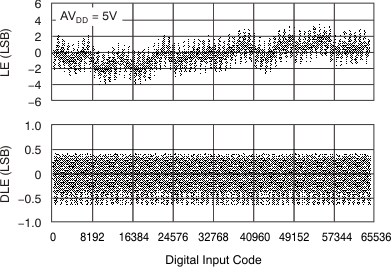
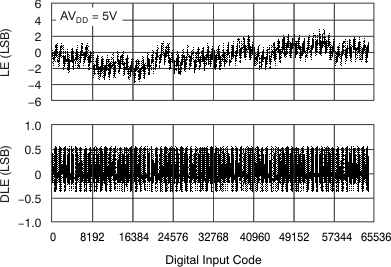
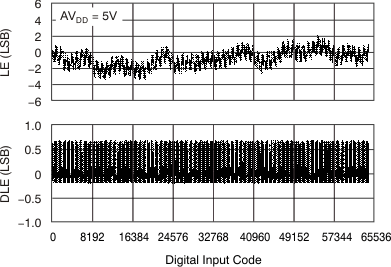
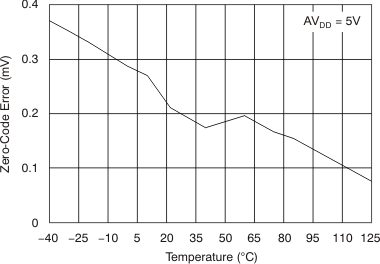
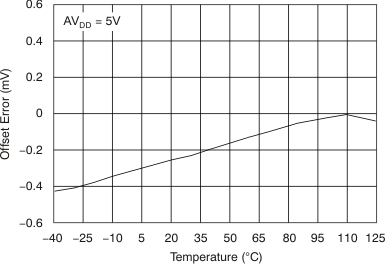
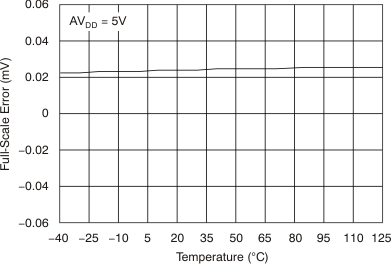

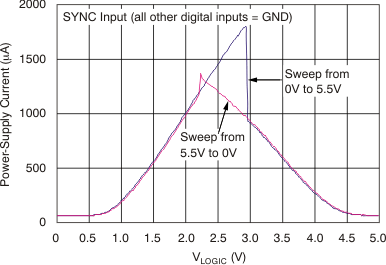
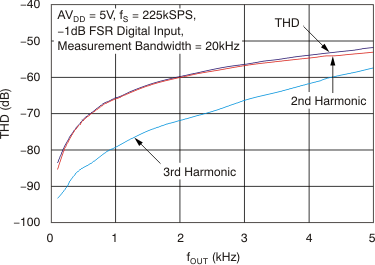
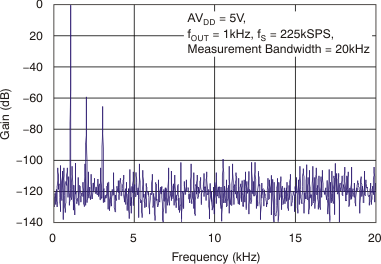
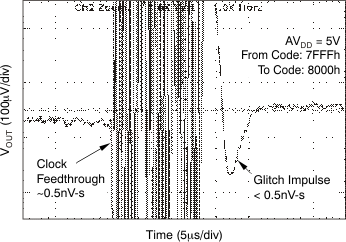
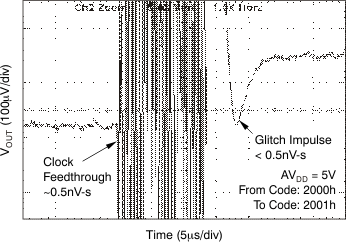
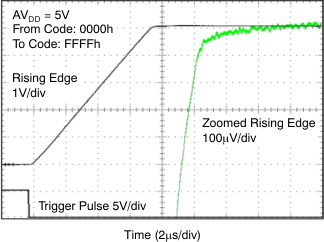
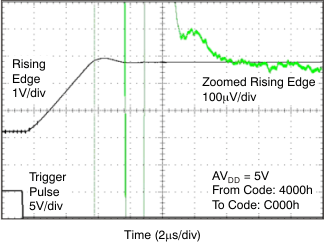
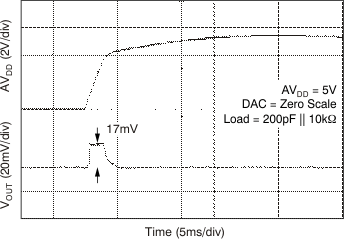
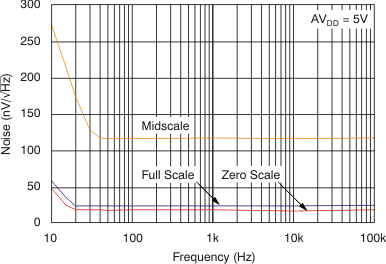
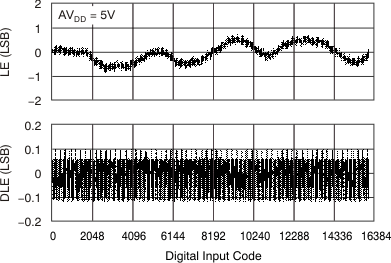
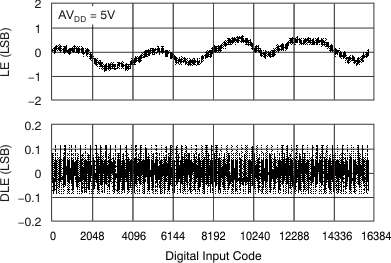
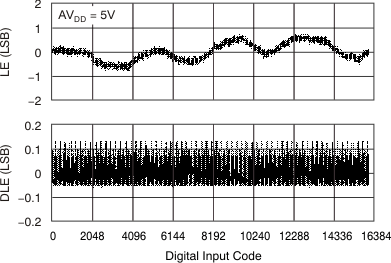
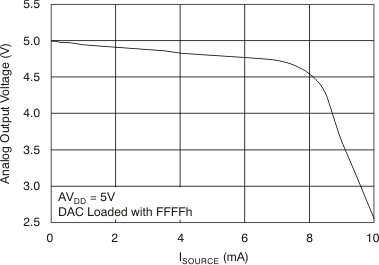
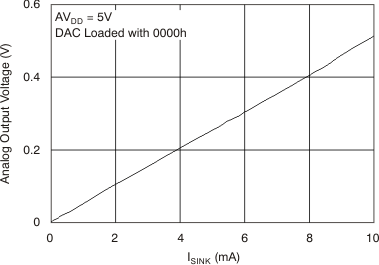
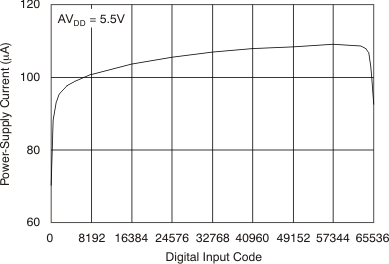
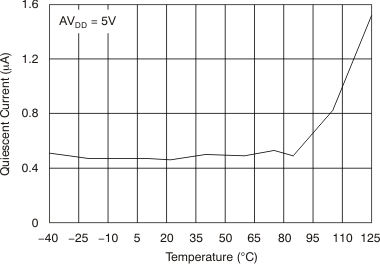
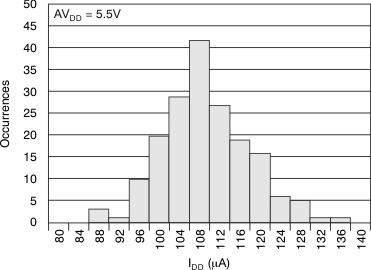
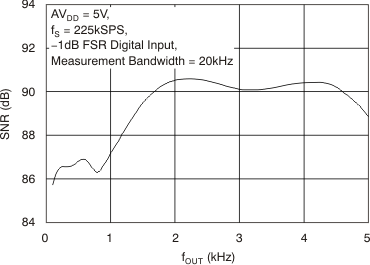
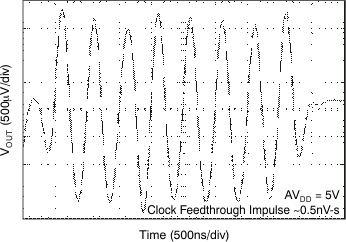
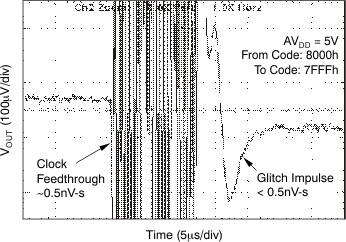
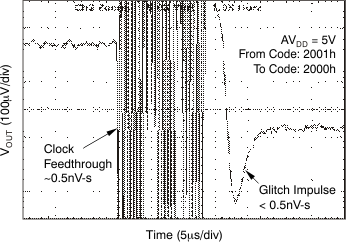
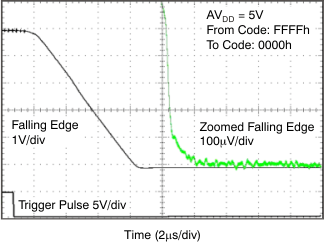
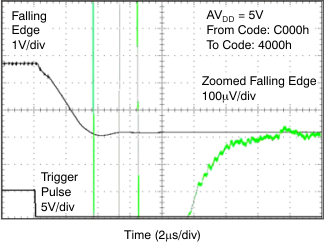
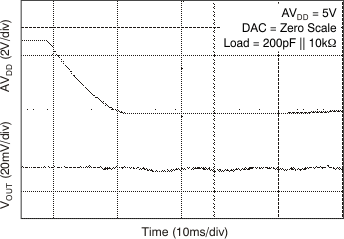
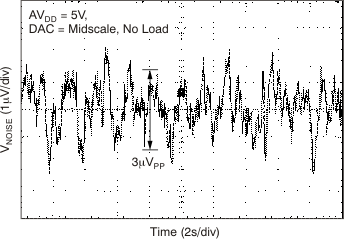
7.8.2 Typical Characteristics: AVDD = 3.6 V
at TA = 25°C, and AVDD = 3.6 V, unless otherwise noted.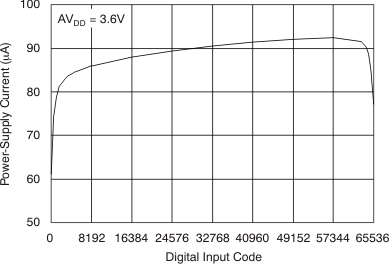
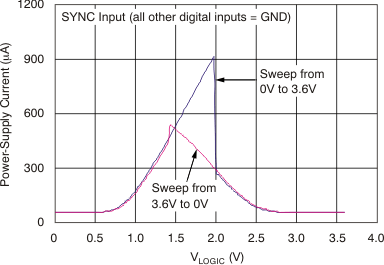
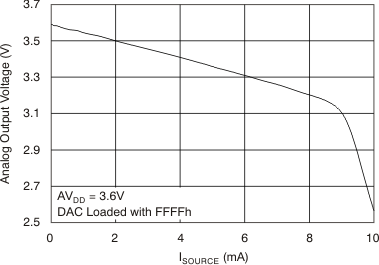
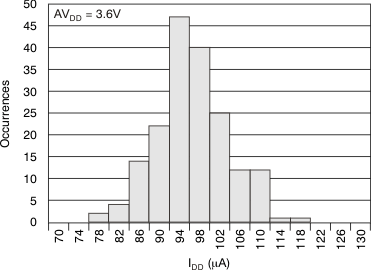
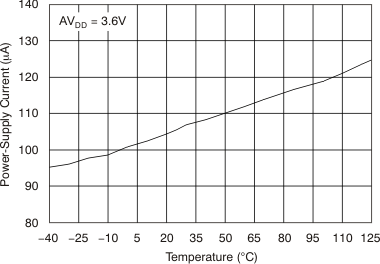
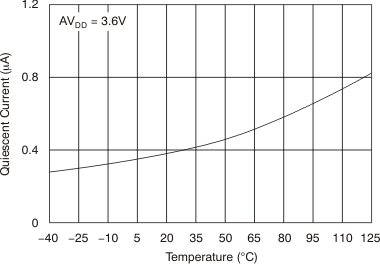
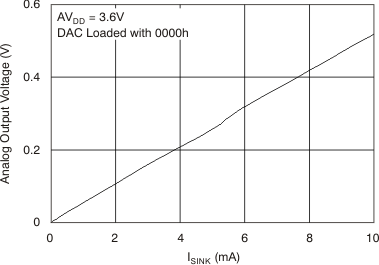
7.8.3 Typical Characteristics: AVDD = 2.7 V
at TA = 25°C, and AVDD = 2.7 V, unless otherwise noted.